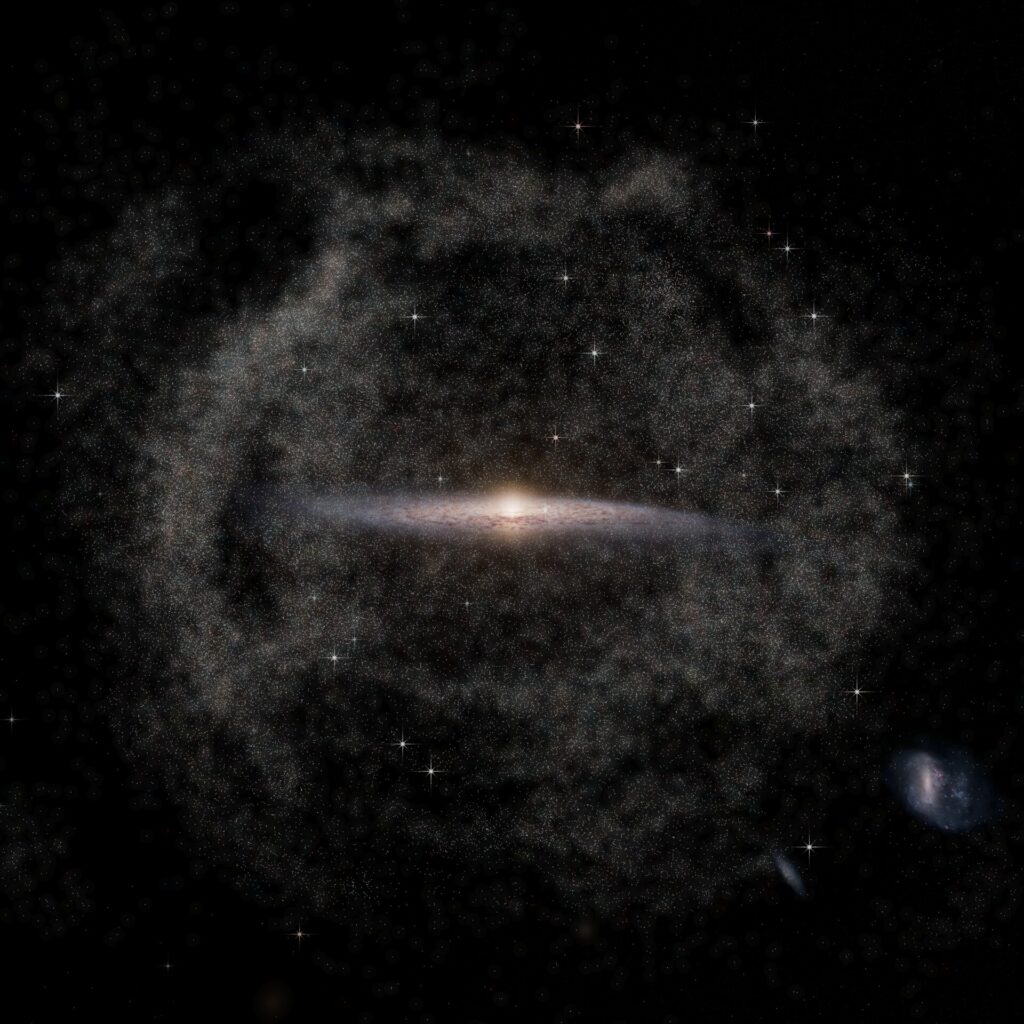
Visualizing a ‘wrinkled’ halo of stars around the Milky Way. Credit: Halo stars: ESA/Gaia/DPAC, T Donlon et al. 2024; Milky Way and Magellanic Clouds background: Stefan Payne-Wardenaar
Our galaxy has collided with many others during its lifetime. ESA’s Gaia space telescope now reveals that the most recent of these collisions happened billions of years later than we thought.
The Milky Way has grown over time as other galaxies have approached, collided, and been torn apart and consumed by our galaxy. Each collision caused ripples that still run through different families of stars, affecting the way they move and behave in space.
One of Gaia’s goals is to unravel the history of our galaxy by studying these wrinkles—something it’s doing by pinpointing the positions and motions of more than 100,000 stars near our own, a tiny fraction of the roughly 2 billion sources it observes.
“We get more wrinkled as we age, but our work reveals that the opposite is true for the Milky Way. It’s a kind of cosmic Benjamin Button that gets less wrinkled over time,” says Thomas Donlon of Rensselaer Polytechnic Institute. and the University of Alabama at. Huntsville, USA and lead author of the new Gaia study published in Monthly Notices of the Royal Astronomical Society.
“By looking at how these wrinkles dissipate over time, we can track when the Milky Way experienced its last big collision – and it turns out that it happened billions of years later than we thought.”
These galactic creases were found by Gaia only in 2018. This study is the first to pinpoint the timing of the collision that created the creases, comparing observations with cosmological simulations.
Strange movements
The Milky Way’s halo contains a large group of stars with unusual orbits, many of which are thought to have been adopted into our galaxy during an event astronomers call the “last big merger.” As the name suggests, this is the last time our galaxy experienced a significant collision with another galaxy – proposed to be a massive dwarf galaxy that flooded the Milky Way with stars that pass too close to our galaxy’s center.
Scientists have dated this merger to between 8 and 11 billion years ago, when the Milky Way was in its infancy, and it is known as Gaia-Sausage-Enceladus (GSE). But data from Gaia – released as part of the telescope’s Data 3 in 2022 – now suggests that another merger may have delivered the extremely mobile stars.
“For the stars’ wrinkles to be as clear as they appear in the Gaia data, they must have merged with us less than 3 billion years ago – at least 5 billion years later than previously thought,” adds co-author Heidi Not Newberg, either. of Rensselaer Polytechnic Institute.
“New star crinkles form every time the stars move back and forth through the center of the Milky Way. If they had joined us 8 billion years ago, there would be so many crinkles next to each other that they wouldn’t we used to see them as special features”.
The discovery suggests that rather than these stars originating from the ancient GSE merger, they must have come from a more recent event called the Virgo Radial Merger, which occurred less than 3 billion years ago.
Rewriting history
There is evidence of GSE merging occurring far back in the history of the Milky Way. However, recent work has questioned whether an ancient massive merger is actually needed to explain the properties of the Milky Way as we see it today, and whether all the stars originally associated with the GSE are from the same merger event .
In 2020, Thomas led the study that identified the wrinkles of stars in the Milky Way and compared them to simulations of different possible mergers.
“We can see how the shapes and number of wrinkles change over time using these simulated mergers. This allows us to determine the exact time when the simulation best matches what we see today in the real Gaia data of the Path of Milk – a method we used in this also new study”, says Thomas.
“In doing so, we discovered that the wrinkles were caused by a dwarf galaxy that collided with the Milky Way about 2.7 billion years ago. We called this event the Virgo Radial Merger.”
Since then, Thomas and colleagues have explored this merger further, slowly working out the idea that many of the strangely moving stars and debris in the Milky Way’s inner halo were delivered to our galaxy by a much more recent galactic collision than GSE. They have also clarified that the stars originally associated with the GSE may have originated from multiple mergers, some ancient.
“The history of the Milky Way is constantly being rewritten at the moment, thanks in no small part to new data from Gaia,” adds Thomas. “Our view of the Milky Way’s past has changed dramatically since a decade ago, and I think our understanding of these mergers will continue to change rapidly.
“This result – that a large part of the Milky Way joined us only within the last few billion years – is a big change from what astronomers thought until now. Many popular models and ideas of how the Milky Way grows they would expect one last head. -A collision with a dwarf galaxy of this mass is very rare.”
It is likely that the Virgo Radial Merger brought a family of other small dwarf galaxies and star clusters with it, which would have all merged with the Milky Way at the same time. Future exploration will reveal which of these smaller objects previously thought to be associated with an ancient GSE are actually associated with a more recent Virgo radial merger.
Incredible collaboration
This discovery joins a stream of results from Gaia that are rewriting the history of our cosmic home. The space telescope is uniquely positioned to explore the countless stars in our sky and has compiled an unparalleled dataset of the positions, distances and movements of some 1.5 billion stars to date.
“Gaia is an extremely productive mission that is transforming our view of the cosmos,” says Timo Prusti, Project Scientist for Gaia at ESA. “Results like this have been made possible thanks to extraordinary teamwork and collaboration between a large number of scientists and engineers across Europe and beyond.”
“This discovery improves what we know about the many complex events that shaped the Milky Way, helping us better understand how galaxies form and are formed – in particular our home galaxy.”
More information:
Thomas Donlon et al, Remnants of the ‘last great merger’ are dynamically new, Monthly Notices of the Royal Astronomical Society (2024). DOI: 10.1093/mnras/stae1264
Provided by the European Space Agency
citation: Gaia: The Milky Way’s Last Major Collision Was Surprisingly Last (2024 June 6) Retrieved June 6, 2024 from https://phys.org/news/2024-06-gaia-milky-major-collision .html
This document is subject to copyright. Except for any fair agreement for study or private research purposes, no part may be reproduced without written permission. The content is provided for informational purposes only.


